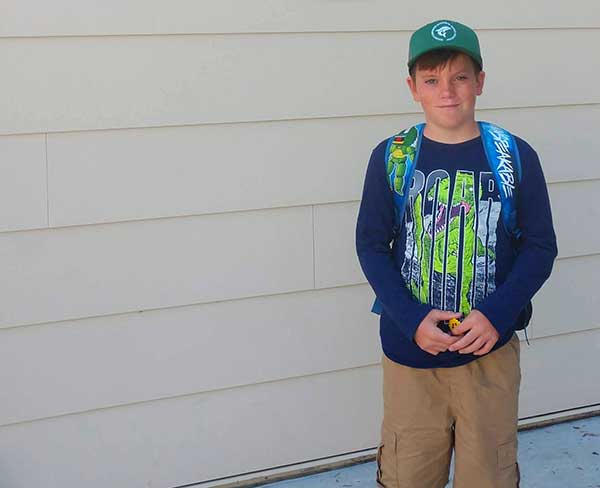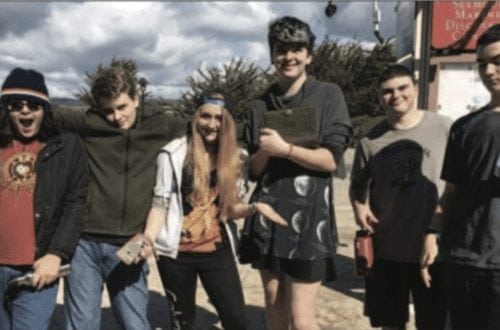Mother Jeanette Prather knew she faced an uphill battle getting help in school when her son was diagnosed with ADHD. This series documents her struggles and the help she received, and yes, it has a happy ending. You can read part 1 at growingupsc.com/how-to-help-your-child-with-adhd-in-school.
I addressed the school issue with this knowledge by reaching out to Alternative Family Education (AFE), who confirmed they had a resource teacher available to work with Luke that year. With some desperate negotiations from his mainstream resource teacher, I decided to keep him in school. Shortly after that, he was invited to a 12-person cohort for students who really needed that help. This was fine for a while and an incredible break from the otherwise hectic Santa Cruz school traffic that I faced every morning on my commute from Scotts Valley (we moved summer of 2019 and let Luke decide if he wanted to stay at his school or change, and he wanted to stay). But then the second shoe dropped; spring 2021 invited all students back to school, full time.
I mistakenly thought that since Luke had been attending school since the November prior, that he would have an easy transition back full time with everyone. Nope. It got so bad that first day as we approached his school, that I thought I was going to have to pull over before he got sick. After we parked, I couldn’t get him out of the car and in a desperate attempt for damage control, I scrambled to the school seeking the school counselor, who happened to know Luke very well. She followed me, as I was nearly in tears, to the car to try and coax Luke out and into his class. The most success she had that morning was a long walk with Luke around the school, an excused tardy and my cell phone number in case I needed to come pick him up. Heartbreak again.
It went on like this for a couple of weeks before he eased into the new routine, right before school let out for summer break 2021 (I still don’t understand why they opened schools in April of that year, then let the kids out at the end of May).
Anyway, after recovering that summer, he was ready for his fifth and final year at that school. That was the year met with the most success, like his second grade year, although I was not so convinced that mainstream would be our path forward. In fact, I had already been “school shopping” for Luke since his late second, early third grade years prior to the pandemic. I was not convinced that we could pull-off middle school with our elementary school track record, and so I began searching for any alternatives I could possibly find.
Restricted by not having the finances for private school, yet every fiber of my being, every cell in my body screaming not to go mainstream again, I began digging and digging and digging…
NOT TOO MANY OPTIONS FOR AN IEP
I would spend Zoom sessions in my Dramatist’s Guild certification class secretly searching for alternative middle school options in Santa Cruz County. I didn’t know about charter schools at this point, but I found a few alternative programs fall of 2021 that looked promising.
As a journalist, I know how to follow leads. So, I spent that fall following one thread and then another until I thought I had found the best solution; an alternative program formerly called Phoenix Academy, presently Santa Cruz Community School. In my research I learned that this was the school for middle school expulsion students and those who’ve accrued too many tardies. The program director had a very innovative, new age approach to middle school curriculum where he would have the kids read classic literature and discuss the books while sitting on their desks; listen to TED talks; create an incentive, community approach to his grading; and offer project-based learning opportunities. He didn’t know who would be in attendance during any points of the year because the program was really created as a fluid launching-off educational platform and not really a stay-and-learn model. I was desperate so I didn’t really care, just loved the director’s approach to learning.
So there. That’s it. October 2021 and I was ahead of the game. I was convinced – and thusly, convinced everyone around me – that this was the program for us. Bonus: It is a seven-minute walk from Luke’s grandparent’s house, so he would just walk there when he was done at 1 pm. Perfect. Reality check: Nothing is perfect.
When I floated this idea to Team Education Luke that year, everyone was sold except for the County Office of Education (COE), who mentioned how early it was and suggested that we wait until after spring break in 2022 to really finalize details. So, we waited.
Spring break came and went, so I eagerly emailed the COE. We set up a meeting with Luke in attendance, and most of the hour was spent emphasizing their hesitation with putting Luke into Santa Cruz Community School. “He’s a really youthful 11-year-old,” they said to me. “We wouldn’t want him to get exposed to too much.”
Heartbreak again. It was May 2022, and I still didn’t know where Luke would attend school in the fall. But knowing that I couldn’t give up on him, I picked myself up by the bootstraps and continued my search.
Do you have stories about how to handle special needs and special abilities students? Have you found successful alternatives you can share? Please write to [email protected]








